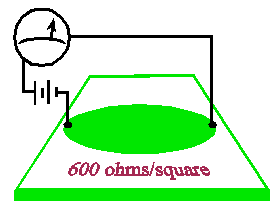|
Copyright ©1997 by Paul Niquette. All rights reserved. |
|
Copyright ©1997 by Paul Niquette. All rights reserved. |
 Now, a conventional conductor, like a
wire, has a constant
crossectional area, so the resistance varies with its
length. The earth
forms what is called a "sheet resistor"...
The engineering unit for sheet resistance is "ohms per square." Hey, ohms per square what?
|
![]()
|
|
|
|
|